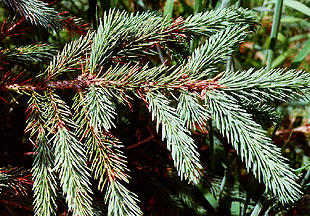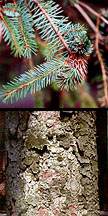  |
|
SITKA SPRUCE Pinaceae Sitka spruce is a large tree, commonly reaching 70 m tall with trunks 2 m in diameter. The bark is thin, reddish- to greyish-brown, and broken into small rough scales. The 1-3 cm needles are yellowish- or bluish-green, rhomboid in cross-section, stiff and very sharp ("spiny spruce"), with two white lines of stomata that are broader on the upper than on the lower surfaces. The needles of all spruces leave behind a raised "peg" when they fall, making needle-less branch segments very rough. The female cones are pendent, cylindrical, 5-8 cm long, reddish-brown to brown, with thin, irregularly wavy-edged scales. Be cautious, however. Many spruces generally have "false cones" formed by microbial infection that look a lot like cones. These are often formed at odd places along a young branch, not at the branch tips where real cones will be found. They also usually have needles sticking out of them instead of typcial cone scales. Sitka spruce most commonly occurs on moist, well-drained soils such as alluvial floodplains, glacial outwash, and old marine terraces, but it can also occur on old logs or mounds within boggy sites. It typically grows at low to middle elevations. The most majestic stands of Sitka spruce in western Washington are found on terraces of the Hoh river floodplains on the western side of the Olympic mountains. |